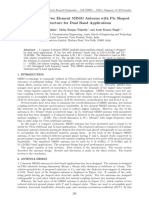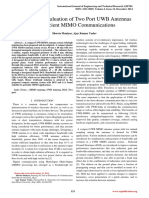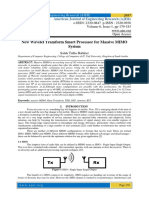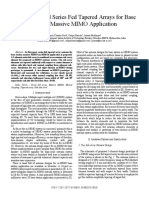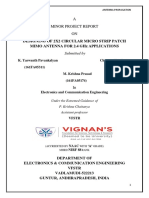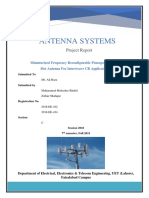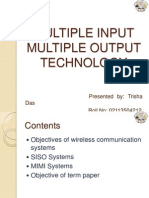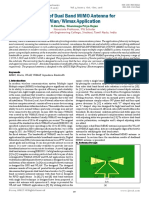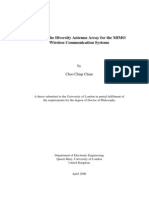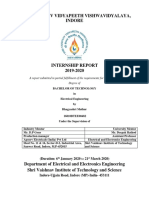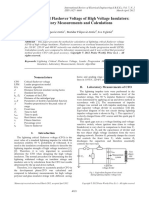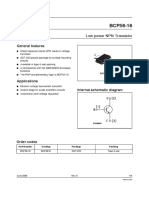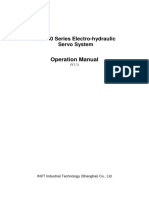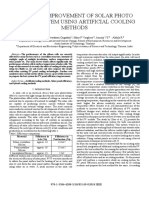International Journal of Computer Applications (0975 – 8887)
National Conference on Innovations and Recent Trends in Engineering and Technology (NCIRET-2014)
Design and Comparison Analysis of Multiple Antenna
Systems for 2.4 GHz ISM Band Frequency using
Microstrip Antennas
Harshal Nigam Mithilesh Kumar
Electronics Engineering Department Electronics Engineering Department
University College of Engineering University College of Engineering
Rajasthan Technical University, Kota, India Rajasthan Technical University, Kota, India
ABSTRACT In this paper, a simple and compact planar antenna is designed
In, this paper, compact antenna have been designed and that shows acceptable return loss for 2.4 GHz ISM band
implemented in a SISO system and multiple antenna systems frequency. This antenna is further used in the design of a 2X2
including 1X2 SIMO, 2X1 MISO and 2X2 MIMO systems MIMO system incorporating the polarization diversity of the two
respectively. The antennas are compact double-sided printed antennas to minimize the correlation between the multiple
microstrip patch antennas and fed by a microstrip line designed signals as in [4], efforts [5–8] have been contributed to the
for a frequency of 2.4 GHz used for industrial, scientific and reduction of mutual coupling between antennas, to achieve
medical (ISM) band applications. The antennas are designed on compactness in MIMO systems, the use of pattern diversity as in
CST Microwave studio simulation software with return loss less [9,10], multimode diversity as in [11], and polarization diversity
than -10dB, the MIMO system is designed using polarization techniques as in [12] in conjunction with space diversity are
diversity of the individual antennas which yields better result in discussed in the literature. The orthogonality of two distinct
terms of return loss (S11 and S22) and mutual coupling (S12 and polarizations constructs independent and uncorrelated signals on
S21).Furthermore, a capacity analysis of the above systems is each antenna and thus leads to potentially a full-rank MIMO
done on MATLAB software. Multiple-Input Multiple-Output channel and a full rank MIMO channel which obviously gives
(MIMO) systems offer highest capacity to wireless systems improved channel capacity. Further, we have designed 2X1
compared to the others. The system is designed for an operation MISO and 1X2 SIMO systems using these antennas.
frequency of 2.4 GHz with MIMO system that offers an
increased data rate.
Keywords
Double-sided Printed, Industrial Scientific and Medical (ISM),
Multiple Input Multiple Output (MIMO), Multiple Input Single
Output (MISO), Single Input Multiple Output (SIMO), Single
Input Single Output (SISO)
1. INTRODUCTION
Multiple input multiple output (MIMO) systems were described
in the mid-to-late 1990s by Gerard Foschini and others, [1] the
diversity and signal processing employed with MIMO
transforms a point-to-point single channel into multiple parallel
or matrix channels, hence multiplying the capacity. A traditional
communications link, which we call a single-input-single-output
(SISO) channel, has one transmitter and one receiver, but instead Fig 1: Multi channel types
of a single transmitter and a single receiver we can use several of
These systems are simulated on CST Microwave studio and
each. The SISO channel then becomes a multiple-input-multiple-
finally a capacity comparison of all these systems is done. This
output, or a MIMO channel. Multi channel types include: SIMO:
paper is organized as follows. In Section 2, the design
Single-Input Multiple-Output is a degenerate case when the
methodology and structure of a basic single antenna is described
transmitter has a single antenna. MISO: Multiple-Input Single-
along with the simulation results. Section 3 incorporates the use
Output is a degenerate case when the receiver has a single
of above antenna to design a simple SISO system along with
antenna MIMO: Multiple-Input Multiple-Output is a case in
simulation results. Section 4 shows the design of MIMO array
which both the ends have multiple numbers of antennas. Fig 1
which is further analyzed for different parameters. In Section 5
shows the details of each of the above systems as in [2]. The
the above antennas are used in a 2X2 MIMO system,
industrial, scientific and medical (ISM) are reserved
polarization diversity is applied to the above MIMO antennas
internationally for the use of radio frequency (RF), the 2.4 GHz
and simulated results are analyzed further. In Section 6, 2X1
ISM band is used for many applications like for Wi-Fi family of
MISO and 1X2 SIMO systems are designed using the basic
standards (802.11 a,b,g,n..), cordless phones, wireless medical
antenna. Section 7 shows the capacity analysis of the above
telemetry equipments and Bluetooth short range wireless
designed systems on MATLAB software using the results from
applications [3]
CST and finally section 8 concludes the analysis of the paper.
14
� International Journal of Computer Applications (0975 – 8887)
National Conference on Innovations and Recent Trends in Engineering and Technology (NCIRET-2014)
2. BASIC ANTENNA DESIGN ANALYSIS there is no problem of mutual coupling as in MIMO system so
The antenna is designed on a substrate printed on both sides. The no diversity techniques are used here. As seen in the Fig 5 the
top and bottom patches printed on the substrate are the radiating two port SISO system having single antenna on both the sides
structure and the ground plane, on one side is the patch and other with a separation of 50 mm between both the antennas which is
side is a ground plane. The geometry of the given antenna is greater than the far field distance The simulation curves for the
illustrated in Fig 2. It is fabricated on a 76.8 X 57.8 mm2 FR-4 two port system are shown combined as S11, S22, S21 and S12 in
substrate with a dielectric constant of 4.3 and a substrate Fig 6, from the curves it can be seen that both the transmitting
thickness of 1.6 mm. The back view is shown in Fig 3.The top and receiving ends are working on the 2.4 GHz ISM band
patch of the substrate has dimension of 39.4 X 28.9 mm2 which frequency (by observing S11 and S22). The channel matrix for
is fed by a strip line having a width of 3.1 mm. The bottom patch the system can be calculated by observing S21 from the plots, at
of substrate is just a ground plane. The proposed antenna has a frequency of 2.4 GHz, this will be the coefficient of the
been simulated by CST Microwave studio. The simulation channel matrix, as it simply denotes the ratio of received and
results of the antenna are shown in Fig 4, from the simulated transmitted voltages, which is the channel matrix coefficient as
graph it is observed that for frequency of 2.4 GHz, S 11<-10dB given by (1)
showing good matching conditions. H = S21 (1)
3. SISO SYSTEM DESIGN ANALYSIS This is the channel matrix for SISO system which will be further
The above antenna will be used for the design of Single Input used for capacity calculation.
Single Output (SISO) system having the same single antenna on
transmitting and receiving sides. Here, the system design is easy,
Fig 2: Antenna geometry with dimensions in mm (front view)
Fig 5: Two port SISO system
Fig 3: Antenna geometry with dimensions in mm (back view)
Fig 6: Simulated result for two port SISO system
Fig 4: Return loss for the antenna
15
� International Journal of Computer Applications (0975 – 8887)
National Conference on Innovations and Recent Trends in Engineering and Technology (NCIRET-2014)
4. MIMO ARRAY DESIGN AND ANALYSIS
The MIMO array is designed using polarization diversity of the
individual antennas, to achieve orthogonal polarization one
antenna is rotated to 900 with respect to its adjacent element as
shown in the Fig 7.The separation between the antennas is 5.75
mm which is 0.046 λ which is also very less leading to a
compact array. The antennas in the array have the same
dimensions as mentioned in Section 2. The antennas are
mounted on a substrate symmetrically with εr = 4.3, which in
turn is mounted on a ground plane. The above two port system is
simulated on CST Microwave Studio simulation software.
The simulation plots for the array are shown in Fig 8. We can
observe that S11<-10 dB for the 2.4 GHz ISM band frequency
and also S22<-10 dB for this frequency. Thus, both antennas are Fig 8: Simulated results for 2 port MIMO array
meeting the specified requirement of return loss also we can see
the S12 and S21 plots for the two port system, we can observe that 5. DESIGN OF 2X2 MIMO SYSTEM
both S12 and S21<-15 dB for the 2.4 GHz ISM band frequency, We have designed the MIMO array, now for the 2X2 MIMO
thus the two antennas are nearly independent of each other and system this array will be used both on transmitting and receiving
value of mutual coupling between the two antennas is very low. end forming a communication system, we can see antennas with
We also calculate the correlation coefficient and diversity gain ports numbered 1 and 2 for transmitting side and ports 3 and 4
for the two antenna array. for the receiving side as in Fig 9. The distance between
transmitting and receiving sides is taken to be 50 mm which is
Correlation coefficient formula using S parameters is given as in greater than the far field distance of the antennas, this is the
(2) same distance that we used for SISO system design. The four
2 port system is simulated on CST Microwave Studio and the
⃒S11∗ 𝑆12 + 𝑆21∗ 𝑆22⃒ channel matrix for the system can be calculated by observing
𝜌= 2 2 (2)
(1 − ⃒𝑆11⃒ 2 − ⃒𝑆21⃒ 2 ) (1 − ⃒𝑆22⃒ − ⃒𝑆12⃒ )
S31, S32, S41 S42 from the simulation plot of the four port system as
in Fig 10, at a frequency of 2.4 GHz, these will be the
coefficients of the channel matrix, as the S parameters simply
It comes out to be 0.000027. This is good because coefficient
denote the ratio of received and transmitted voltages, these ratios
correlation should be < 0.1 for MIMO antenna. Diversity gain is
denote channel matrix coefficient.
the increase in signal to noise ratio due to the diversity scheme
which is given by the formula in (3) The channel matrix for the 2X2 system as in (4)
𝐷𝐺 = 10 ∗ 1 − 0.99 ∗ 𝜌 2 (3) 𝑆31 𝑆32
𝐻= 4
It comes out to be 9.9 dB, which shows an acceptable gain in 𝑆41 𝑆42
terms of diversity. This channel matrix will be further used for capacity analysis of
this system.
Fig 7: MIMO array of two antennas
Fig 9: 2X2 MIMO system with four ports
16
� International Journal of Computer Applications (0975 – 8887)
National Conference on Innovations and Recent Trends in Engineering and Technology (NCIRET-2014)
Fig 10: Simulation result for the 2X2 MIMO system
6. SIMO AND MISO SYSTEM DESIGN
In, the previous sections we have designed the SISO and MIMO Fig 12: Simulated result for MISO system
systems. SIMO systems have single antenna on the transmitting
end and two antennas on the receiving end, respectively.
Similarly, MISO systems have two antennas on the transmitting
end and single antenna on the receiving end, respectively, to
implement these two systems, the single antenna is placed facing
the center point of the distance between the two antennas on
other side, means it is kept at equal distances from the two
antennas facing it. These, three port systems are simulated on
CST microwave studio. Considering, the MISO case first, we
can see the design of the system as in Fig 11 with ports
numbered 1 and 2 for the transmitting end and port 3 for the
receiving end respectively. The distance between the two
antenna systems is kept same as taken in previous sections. The
simulated S parameter results for this system is as shown in Fig
12, we can observe that antennas in the array are working
independently of each other by observing S11 and S22 and also
that receiving end is also working on same frequency as
transmitting side. The channel matrix of the system can be
obtained as in (5).
𝐻 = 𝑆31 𝑆32 (5)
This matrix will be used for further analysis of the system.
In the same way, SIMO system is also designed having single
antenna on transmitting end and multiple antennas on receiving
end. The 3 port system is shown in Fig 13 with the same Fig 13: Three port SIMO system
distance between the two ends as taken previously. The
simulated results are as shown in Fig 14. The channel matrix for
the system is as in (6)
𝑆31
𝐻= (6)
𝑆41
Fig 14: Simulated result for SIMO system
7. CAPACITY ANALYSIS OF ABOVE
SYSTEMS
Channel capacity is the maximum information rate that can be
transmitted and received with arbitrarily low probability of error
at the receiver. It can be expressed in bps/Hz for a unit
bandwidth. Compared to a conventional single antenna system,
the channel capacity of a multiple antenna system with NT
transmit and NR receive antennas can be increased by the factor
of min (NT, NR) without using additional transmit power or
spectral bandwidth. In this section we will compare the capacity
of above systems using the channel matrix for each.
Fig 11: Three port MISO system
17
� International Journal of Computer Applications (0975 – 8887)
National Conference on Innovations and Recent Trends in Engineering and Technology (NCIRET-2014)
7.1 Capacity of SISO System 10
According to Shannon capacity of wireless channels, given a SISO
single channel corrupted by an additive white Gaussian noise at 9 1X2 SIMO
a level of SNR, the capacity is given as data rate per channel use 8
2X1 MISO
as in (7) 2X2 MIMO
7
C = log2 1 + SNR bps/Hz (7)
6
where C is the Shannon limits on channel capacity, SNR is
bps/Hz
signal-to-noise ratio, in the practical case the capacity is given as 5
in (8) 4
𝐶 = 𝑙𝑜𝑔2 1 + 𝑆𝑁𝑅 I𝐻I 2 (8) 3
where H is the 1x1 channel matrix which we will be using from 2
our design of SISO system as in section 3.
1
7.2 Capacity of SIMO and MISO Systems 0
For the SIMO system, we have N antennas at receiver and only 0 2 4 6 8 10 12 14 16
SNR[dB]
one at transmitter. The same amplitude signals are added
coherently and noise is added incoherently to produce an overall Fig 15: Capacity comparison of above systems
increase in SNR compared to SISO case. The capacity is given
as in (9) 8. CONCLUSION
𝐶 = 𝑙𝑜𝑔2 det 𝐼 + 𝑆𝑁𝑅 ∗ 𝐻′𝐻 (9) A new methodology has been defined by designing practical
systems and a capacity enhancement of the 2X2 MIMO system
Where I is the identity matrix of order n given by min (M, N), over the other system is shown along with the design
here M=1 which is the number of transmitting antennas and N=2 considerations. The system is operating on 2.4 GHz ISM band
that is the number of receiving antennas and H is the channel frequency using practical antennas designed on CST Microwave
matrix for the SIMO system. studio. We have analyzed the MIMO array and found that the
For the MISO system, we have M antennas at transmitter and antennas in the MIMO system are operating independently of
only one at receiver. The capacity in this case is given as in (10) each other which is a necessary requirement for MIMO system
design. The performance analysis of the different multiple
𝑆𝑁𝑅 antenna systems along with SISO systems is done by using the
𝐶 = 𝑙𝑜𝑔2 det 𝐼 + 𝐻𝐻′ (10)
𝑀 channel matrix from CST instead of using a random channel
Where H is the channel matrix for the MISO system as designed matrix. We can see that Multiple-Input Multiple-Output
above and other parameters remaining same as above with M=2 (MIMO) systems offer high capacity to wireless systems and the
and N=1. capacity increases as long as the number of receiving antennas is
greater than or equal to the number of transmitting antennas.
7.3 Capacity of MIMO System MIMO systems offer an increased capacity but this requires a
For the MIMO system, we have M antennas at transmitter and N complex design and problems associated with mutual coupling
antennas at receiver. The signals received on multiple antennas need to be taken care of otherwise they create huge interference,
at the receiver are added coherently also there is an incoherent also the cost for designing the system is high.
addition of noise so there is increase in signal to noise ratio
which is greater than the SIMO and MISO case. For a MIMO 9. REFERENCES
system the capacity is given as in (11) [1] G. Foschini, M. Ganns. 1998. On limits of wireless
communications in a fading environment when using
𝑆𝑁𝑅 multiple antennas,Wireless Personal Comminications pp.
𝐶 = 𝑙𝑜𝑔2 det 𝐼 + 𝐻′𝐻 (11)
𝑀 311-335.
where H is the combined channel matrix for the 2X2 system as [2] G.J.Foschini.1996. Layered space-time architecture for
obtained from section 4. With other parameters remaining the wireless communication in a fading environment when
same as above cases with M=2 and N=2.Thus, we calculate the using multi element antennas. BLTJ, Autumn
channel capacity for both cases as shown in Fig 15.
[3] International Telecommunication Union. 19 October 2009.
7.4 Capacity Enhancement 1.15. industrial, scientific and medical (ISM) applications
We can see from Fig 15 that there is a capacity enhancement of (of radio frequency energy): Operation of equipment or
the MIMO system over the other three systems, this is because appliances designed to generate and use locally radio
MIMO system creates different paths and so number of bits sent frequency energy for industrial, scientific, medical,
per second will be increased and also it can be seen that as domestic or similar purposes, excluding applications in the
number of receiving antennas increase capacity increase as the field of telecommunications.
capacity of SIMO system is more than that for MISO case.
[4] Emami-Forooshani,S. Noghanian. 2010. Semi-deterministic
channel model for MIMO systems Part-II: results. IET
microwaves, antennas & propagation, Vol.4 pp 26-34.
[5] Ganatsos,T.,K. Siakavara, and J. N. Sahalos. 2007 Neural
network based design of EBG surfaces for effective
polarization diversity of wireless communications antenna
systems. PIERS Online, Vol. 3, No. 8, 1165–1169.
18
� International Journal of Computer Applications (0975 – 8887)
National Conference on Innovations and Recent Trends in Engineering and Technology (NCIRET-2014)
[6] Ren,W. 2008. Compact dual-band slot antenna for 2.4/5 [10] Mukherjee and Hyuck M. Kwon. 2007. Compact Multi-
GHz WLAN applications. Progress In Electromagnetics user Wideband MIMO System Using Multiple-Mode
Research B, Vol. 8,319–327. Microstrip Antennas. Proceedings of Vehicular Technology
Conference Spring 2007. pp 584-588.
[7] Khaleghi,A. 2006. Diversity techniques with parallel dipole
antennas: radiation pattern analysis. Progress In [11] Waldschmidt, C. Kuhnert, S. Schulteis, and W. Wiesbeck,.
Electromagnetics Research PIER 64,23–42. 2003. Compact MIMO-Arrays Based on Polarization-
Diversity. Proceedings of IEEE Antennas and Propagation.
[8] Tu,T.-C.,C.-M. Li,and C.-C. Chiu, 2005. The performance Symp. Vol.2, pp. 499-502.
of polarization diversity schemes in outdoor micro cells.
Progress In Electromagnetics Research, PIER 55,175–188. [12] M. A. Jensen, J. W. Wallace. 2004. A review of antennas
and propagation for MIMO wireless communications. IEEE
[9] Matilde Sanchez-Fernandez, Eva Rajo-Iglesias, Oscar Trans. Antennas Propagation., Vol. 52, pp. 2810-2824.
Quevedo-Teruel, M. Luz Pablo-Gonzalez. 2008 Spectral
Efficiency in MIMO Systems Using Space and Pattern
Diversities Under Compactness Constraints. IEEE T 1637-
1645.
19






